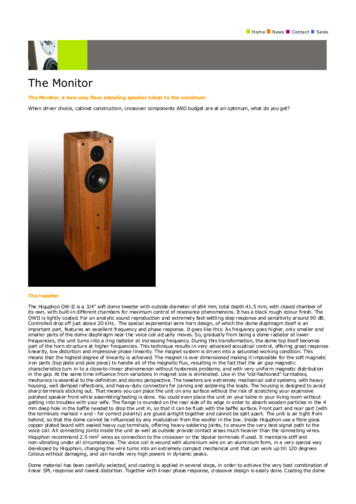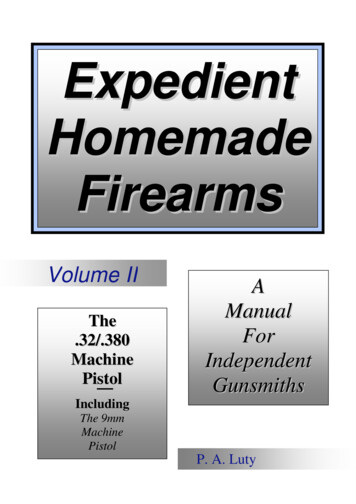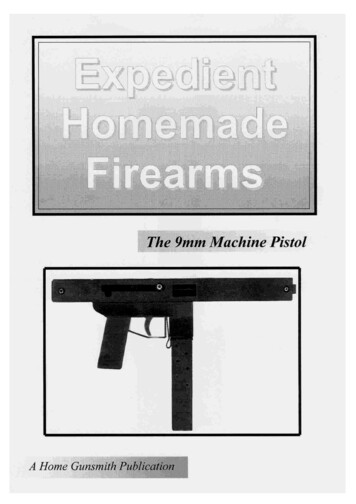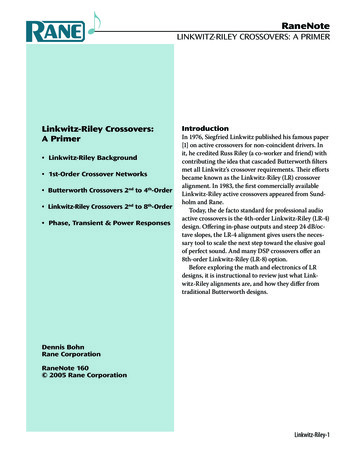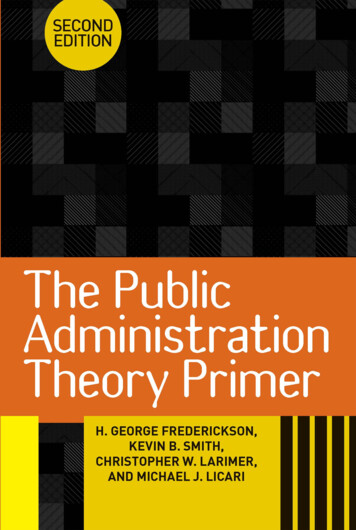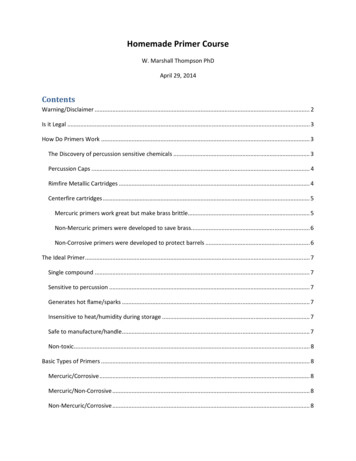
Transcription
Homemade Primer CourseW. Marshall Thompson PhDApril 29, 2014ContentsWarning/Disclaimer . 2Is it Legal . 3How Do Primers Work . 3The Discovery of percussion sensitive chemicals . 3Percussion Caps . 4Rimfire Metallic Cartridges . 4Centerfire cartridges . 5Mercuric primers work great but make brass brittle. 5Non-Mercuric primers were developed to save brass. 6Non-Corrosive primers were developed to protect barrels . 6The Ideal Primer . 7Single compound . 7Sensitive to percussion . 7Generates hot flame/sparks . 7Insensitive to heat/humidity during storage . 7Safe to manufacture/handle . 7Non-toxic . 8Basic Types of Primers . 8Mercuric/Corrosive . 8Mercuric/Non-Corrosive . 8Non-Mercuric/Corrosive . 8
Non-Mercuric/Non-Corrosive . 9Reliable Homemade Primers . 9Preparation of primer cups . 9Primers made from toy caps . 10Primers made from strike-anywhere matches . 11Primers made with H-48 compound . 12Making Non-Mercuric/Non-Corrosive Primers . 14The required compounds cannot be purchased/shipped. . 14Special storage conditions for these materials are required . 14Special mixing facilities are required to safely combine and mix the primer components together. 15Special facilities (e.g. blast proof building) are needed to wet load primer compounds into primercups. . 15Drying facilities are required to remove water from loaded primer cups. 15Finished primers must be safely stored. . 15Testing of primer batches may be required to assure they work correctly . 15Appendix . 15References . 15Primer chemical suppliers . 16Primer formulations . 16Synthesis of primer chemicals . 17Warning/DisclaimerThis course discusses the creation and work with chemical compounds and mixtures that present a realrisk of serious injury and/or death if mishandled. In addition, some of the chemicals discussed are toxicand present a danger to a person’s health if inhaled or ingested. Primer compounds are considered tobe “Primary” explosives. This designation is a result of the sensitivity of these materials to percussion,heat, and sparks (both electrical and mechanical) and their intense power during detonation. Therefore,anyone who uses this information to make primer compounds or primers does so at their own risk. The
creators and instructors of this course will not be held legally liable for any accidents or injuries resultingfrom this information.To avoid serious injury or death, always work with primer compounds in small quantities of less than 2grams ( 30 grains) at a time. Always wear eye protection and work in a clutter free, well-ventilated area.It is recommended that wood, plastic, or other non-sparking tools be used to avoid accidental ignition ofprimer compounds and primers. Work on a non-porous surface and carefully clean up all residue anddust from the work area when finished. It is important to wash your hands thoroughly with soap andwater after working with primer compounds to avoid accidental poisoning.Is it LegalAccording to current BATFE rules, making ammunition primers for your own personal use is legal (as ismaking your own fireworks.) Selling them or even giving them away is not legal without acquiring theappropriate Federal Licence(s) for manufacturing and selling explosives. Despite the absence of Federalrestrictions on personal primer manufacture, there may be state regulations that affect how you storecertain chemical compounds and in what quantities they may be stored. Consult competent legal adviceif you are unsure of your particular situation. Be aware that making primers in your home, garage, orexternal workshop is likely to carry more restrictions than making them in a commercially zonedbuilding.So, making primers on a small scale for your own personal use is unlikely to get you into trouble. Nonethe-less, expect your name to appear on some government list if you purchase several of the chemicalsneeded to make various primer mixtures. Finally, some very useful chemicals for making primers arelegally restricted by the government (e.g. Red Phosphorus) and cannot be legally purchased orpossessed by individuals who do not have the appropriate licenses or work for a company that has alegitimate need for those chemicals.How Do Primers WorkThe Discovery of percussion sensitive chemicalsIn the 1700’s and early 1800’s, a number of chemists made various compounds that were found to besensitive to shock, heat, friction, and sparks. While many of these compounds were extremely sensitivedangerous and unpredictable, others were more tame and although risky could be manipulated andused for various purposes such as military explosives. One such material was mercury fulminate whichwas easily synthesized from metallic mercury, alcohol and acid.In general, all percussion sensitive chemicals are ignited in the same way under a sharp blow. As thematerial is crushed, sharp edges on some of the primer ingredients rub against one another creatingfriction and very localized high temperatures. When these temperatures become high enough, thereaction of the primer mixture is initiated and rapidly spreads throughout the mass generating heat,flames and incandescent particles. There is a threshold of impact energy that must be crossed to ignite agiven primer mixture. This threshold energy is routinely measured by commercial primer manufacturers
on every lot of primers they make to be sure they are neither too sensitive (e.g. round goes off whenaccidentally dropped on a hard surface) nor too insensitive to impact (e.g. misfires.)Percussion CapsDuring this same time, flintlocks were the state-of-the-art in firearms but suffered from unreliableignition, especially in rainy or damp conditions (recall the admonition to “keep your powder dry”.) Thesearch for a better ignition system eventually brought the shock sensitive compounds together withfirearms. Percussion caps were first made and patented in the early 1800’s and were widely used untilthe end of the Civil War. These caps were typically composed of a copper cup partially filled with amixture of mercury fulminate and several other chemical compounds. The caps were placed over anipple containing a hole that led to the powder charge inside the barrel. When struck by the gun’shammer, the primer compound exploded sending hot gases and sparks through the nipple to thepowder charge causing it to ignite. This invention greatly improved the ignition reliability of muzzleloading guns.Rimfire Metallic CartridgesSeveral decades after the development of percussion caps, a self-contained metallic cartridge wasdesigned that placed the primer compound into a deformable hollow rim. The 22 short was the firstmetallic cartridge introduced in the US (1857) and continues to be commercially available to this day.Other larger caliber (up to 56 caliber) rimfire cartridges were designed and used in the Civil War andwere commercially available until the early 1900’s. All of these larger caliber rimfire cartridges wereeventually replaced by the superior centerfire design due to the pressure limitation of the rimfire casing.The requirement to have a rim that was thin and soft enough to crush with the firing pin limited theinternal pressure that these casings could safely contain without failing.
Centerfire cartridgesShortly after the Civil War, new cartridge designs were developed to make the production ofammunition more efficient. Eventually, the current centerfire cartridge design was developed that useda separate primer located in the center of the cartridge head. A major advantage of this design was thatthe cartridges could be easily reloaded by replacing the fired primer with a new one, refilling the casewith gunpowder, and pressing in a new bullet. Reloading tools quickly appeared allowing cowboys toreload their ammunition while sitting around the campfire in the evenings.Mercuric primers work great but make brass brittleThe same types of priming compounds originally used in percussion caps were still being used inthe new centerfire primers. It was discovered that the cartridge brass became brittle and tendedto crack when reloaded. This embrittlement was found to be caused by residues from themercury fulminate based primers. Metallic mercury formed during the combustion of mercuryfulminate selectively attacked and amalgamated the zinc in the brass alloy causing it to becomebrittle. Pure copper casings were briefly used to avoid this problem, however, copper was found
to be too soft to hold up well to the high pressures generated during firing. Therefore, topreserve the brass for reloading a new primer compound was needed that did not use mercuryfulminate. Despite the knowledge that mercury fulminate based primers ruined brass casings forreloading, non-corrosive mercuric primer formulations continued to be used in commercialammunition until the early 1940’s.Non-Mercuric primers were developed to save brassIn the late 1800s mixtures of potassium chlorate (KClO3) with various “fuels” were found to besuitable for use in primers. These mixtures were reliable and had a long storage life even underunfavorable conditions commonly encountered in military campaigns. The main negative aspectof these primers was their “corrosive” effects on steel barrels and receivers. This was especiallynoticed with the conversion from black powder to smokeless powder which occurred aroundthe same time. When black powder burns it produces a large quantity of soot and otherresidues that coat the inside of the gun barrel. This powder residue was found to create aprotective barrier to the corrosive effects of potassium chlorate primer residues. Whenammunition cartridges began using smokeless powders, they burned
The primer must be sensitive enough to be reliably set off by the firing pin strike, but not so sensitive to be set off by normal manufacturing and handling processes. Ever notice that accidentally dropped rounds almost never fire? This is why. Generates hot flame/sparks Obviously the fired primer has to generate enough energy to ignite the propellant. This is relatively easy when fast pistol .

